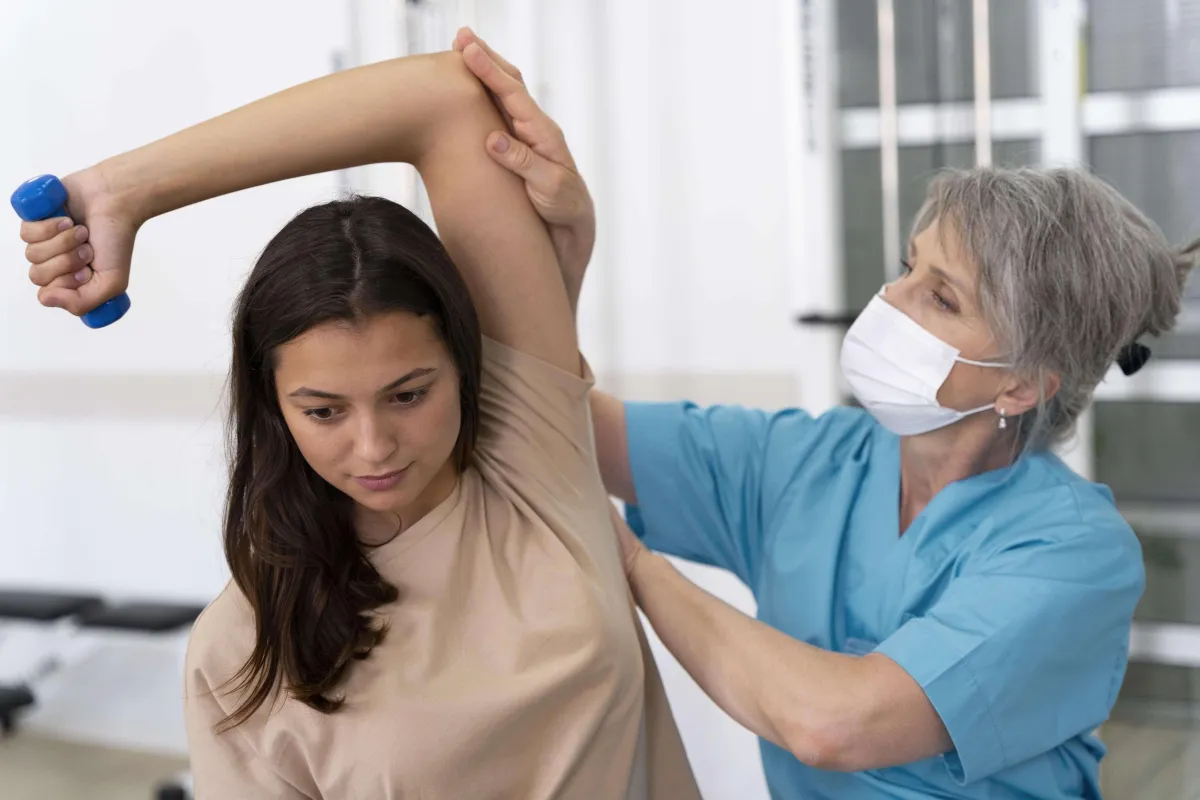Physical Therapy for Shoulder Pain in NYC
Manhattan Physical Therapy

Key Takeaways:
Shoulder pain often results from rotator cuff injuries, impingement, or poor posture.
Physical therapy effectively restores strength, flexibility, and pain-free movement.
Manual therapy, therapeutic exercise, and posture correction form the foundation of successful treatment.
Recovery time varies, but consistency and early care lead to faster results.
Call (212)-213-3480 to book your appointment
What is shoulder pain and how does it affect you?
Shoulder pain ranges from mild stiffness to severe, movement-limiting pain. Common sources include rotator cuff tendinopathy, impingement, adhesive capsulitis (frozen shoulder), bursitis, and post-surgical stiffness. When shoulder or hip issues lead to altered gait and knee stress, our knee pain physical therapy service may form part of a multidimensional plan.
Pain often reduces range of motion, weakens the shoulder, and makes overhead or reaching tasks difficult. If you have associated back or leg symptoms along with shoulder pain, our sciatica program may uncover lumbar-hip nerve dynamics contributing to your shoulder issue.
Why does physical therapy work for shoulder pain?
Physical therapy treats the underlying movement, strength, and mobility problems that cause pain, not just symptoms.
Evidence shows structured, progressive exercise and movement retraining improve pain and function for many shoulder conditions, including some rotator cuff tears and impingement syndromes.
Therapists also use hands-on techniques, education about pain and activity modification, and staged rehabilitation to restore function safely.
Who should consider physical therapy for shoulder pain?
Anyone with persistent shoulder pain that limits daily activities should consider evaluation by a licensed physical therapist.
Patients with recent injuries, postoperative stiffness, progressive weakness, or frozen shoulder often benefit most from early, guided rehabilitation.
If you have numbness, fever, obvious deformity, or severe night pain that won’t respond to simple measures, seek urgent medical evaluation first.
When should you start physical therapy?
Start when pain or stiffness persist beyond a few weeks despite home care (rest, brief ice/heat, and over-the-counter pain relief), or earlier if pain disrupts work or sleep.
Early supervised therapy can prevent chronic stiffness (especially with adhesive capsulitis) and improve outcomes after rotator cuff injuries or surgery.
Upper-body issues often span neck and shoulder. If the root cause is cervical, consider our neck pain physical therapy plan. A therapist will perform a thorough assessment and create a timeline based on your diagnosis, symptom irritability, and goals.
How does a typical physical therapy program for shoulder pain work?
Assessment: The therapist will take your history, observe posture and shoulder mechanics, and test strength and range of motion to identify the pain generator.
Pain control and protection: Early sessions focus on reducing inflammation and pain with education, safe activity modification, ice/heat guidance, and gentle hands-on care when appropriate.
Mobility and flexibility: Guided stretching and progressive range-of-motion exercises (passive → active-assistive → active) restore joint mobility while protecting healing tissues.
Strength and motor control: Programs emphasize rotator cuff and scapular stabilizer strengthening plus movement retraining to correct faulty mechanics that drive pain. Clinical guidelines support progressive strengthening as a core element of nonoperative rehab.
Functional return and prevention: Therapy progresses to sport- or job-specific training, ergonomic advice, and home programs to prevent recurrence. Therapists teach gradual return-to-activity plans tailored to your goals.
Where can you find quality physical therapy for shoulder pain in NYC?
New York City offers many clinics and specialists, but few provide the personalized, evidence-based care that patients truly need. At Manhattan Physical Therapy, treatment is led by highly trained physical therapists who specialize in shoulder rehabilitation. The clinic emphasizes one-on-one sessions, detailed movement analysis, and customized exercise programs that evolve with your recovery.
Whether your pain stems from sports, posture-related strain, or a surgical procedure, the therapists here ensure every session addresses the root cause—not just the symptoms. This approach helps patients recover faster, avoid repeat injuries, and restore full function in their daily lives.
Which techniques are commonly used in shoulder pain therapy?
A comprehensive shoulder rehabilitation program in NYC typically combines multiple modalities, including:
Manual therapy: Hands-on joint mobilizations, myofascial release, and trigger point techniques improve shoulder mobility and reduce soft tissue tension.
Therapeutic exercises: Strengthening the rotator cuff, scapular stabilizers, and postural muscles restores stability and prevents impingement.
Neuromuscular re-education: This focuses on retraining proper movement patterns so that the shoulder moves efficiently without strain.
Kinesio taping and postural correction: These techniques reduce strain on healing tissues and improve shoulder alignment.
Modalities for pain relief: Ultrasound, electrical stimulation, and cryotherapy can help decrease inflammation and discomfort early in the recovery process.
How long does shoulder physical therapy take?
Recovery time depends on your condition, consistency, and overall health.
Mild strains or overuse injuries: Usually resolve within 4–6 weeks with consistent physical therapy.
Moderate injuries (e.g., tendonitis or impingement): Often require 8–12 weeks of guided therapy.
Post-surgical recovery: Can take 3–6 months of structured rehabilitation before regaining full strength and motion.
Mild strains or overuse injuries:Mild strains or overuse injuries: Usually resolve within 4–6 weeks with consistent physical therapy.
Moderate injuries (e.g., tendonitis or impingement): Often require 8–12 weeks of guided therapy.
Post-surgical recovery: Can take 3–6 months of structured rehabilitation before regaining full strength and motion.Mild strains or overuse injuries: Usually resolve within 4–6 weeks with consistent physical therapy.
Moderate injuries (e.g., tendonitis or impingement): Often require 8–12 weeks of guided therapy.
Post-surgical recovery: Can take 3–6 months of structured rehabilitation before regaining full strength and motion.
What results can you expect from shoulder physical therapy?
Most patients experience noticeable improvement in pain and mobility within the first few weeks of therapy. With time, physical therapy helps you:
Regain full shoulder range of motion.
Strengthen supporting muscles to prevent re-injury.
Improve posture and joint alignment.
Return to sports, fitness, or work-related tasks pain-free.
Which lifestyle habits help prevent shoulder pain recurrence?
Prevention is a major part of long-term success. To reduce future shoulder problems:
Incorporate shoulder and upper-back stretches into your daily routine.
Warm up properly before exercise or sports.
Use ergonomic adjustments for workstations, especially if you sit for long hours.
Avoid carrying heavy bags on one shoulder.
Keep your core and postural muscles strong, since poor posture increases shoulder strain.
How can you get started with treatment?
If you’re living with shoulder pain that affects your daily life, don’t wait for it to worsen. Early intervention through physical therapy can prevent chronic issues and speed up your return to normal activities.
Call (212)-213-3480 to book your appointment and start your recovery journey today.
What Do They Say About Us?
Alexander Liu
"Everyone on the team at Manhattan Physical Therapy is super nice and caring. They were able to pretty quickly diagnose my knee and hip problems and immediately put me to work to reduce the pain.."
Henry Myerberg
"You're not just a patient when you come to the Manhattan Physical Therapy. You feel like family there. In particular, Erica with her colleagues John, Lidia and Joe not only fix and improve you physically, they make you feel welcomed and cared for.."
Hakyung Kim
"Everyone is so kind and helpful! my knee and hip pain have improved massively since starting Manhattan PT, highly recommend to anyone. special thanks to Bianca, Lidia, Joe, and John!"
Manhattan Physical Therapy
✆ Phone (appointments):
(212) 213-3480
Address: 385 5th Ave, Suite 503, New York, NY 10016

